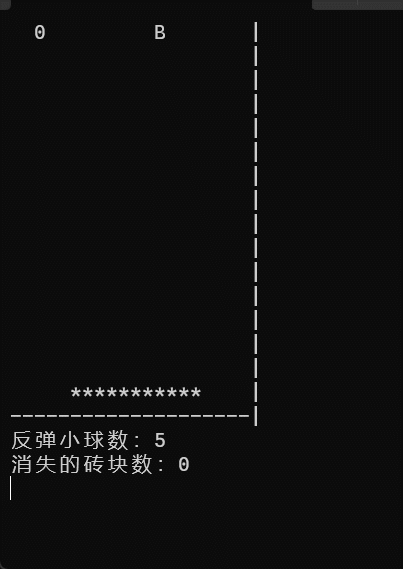目录
1:基础的小球运动
1:下落的小球
2:上下弹动的小球
3:上下左右弹动的小球
4:控制速度
2:函数包装的小球运动
1:代码重构
1:数值在函数间的传递
2:光标移动函数
2:显示边框
3:显示移动的挡板
4:反弹小球
5:消除砖块
3:小结
1:基础的小球运动
1:下落的小球
要实现下落的小球,即改变小球的位置,即坐标变量,让小球的竖直坐标y增加即可,结合清屏函数system(”cls"),每一次输出y都增加一次,即可实现小球的下落运动。
#include <stdio.h>
#include <stdlib.h> //清屏函数头文件
int main()
{
int i,j;
int x=5;
int y=10;
int hight=20;
int velocity=1;
while(1)
{
x=x+velocity;
system("cls");
for(i=1;i<x;i++)
{
printf("\n");
}
for(j=1;j<y;j++)
{
printf(" ");
}
printf("o");
printf("\n");
}
return 0;
}这样就得到了一个竖直下落的小球。
2:上下弹动的小球
上面写出了竖直下落的小球,当小球下落刀边界时,改变位移改变值的正负。
#include <stdio.h>
#include <stdlib.h>
int main()
{
int i,j;
int x=5;
int y=10;
int hight=20;
int velocity=1;
while(1)
{
x=x+velocity;
system("cls");
for(i=1;i<x;i++)
{
printf("\n");
}
for(j=1;j<y;j++)
{
printf(" ");
}
printf("o");
printf("\n");
if(x==hight) //当小球到达边界时,改变位移改变值的方向。
{
velocity=-velocity;
}
if(x==0)
{
velocity=-velocity;
}
}
return 0;
}3:上下左右弹动的小球
有了上面竖直弹动的小球,在水平上增加一个运动变量,提供位移改变值信息,即可实现小球的水平碰撞,效果和竖直的相同,都是通过改变正负号,依葫芦画瓢即可。
#include <stdio.h>
#include <stdlib.h>
int main()
{
int i,j;
int x=5;
int y=10;
int velocity_x=1;
int velocity_y=1;
int top=0;
int botton=10;
int left=0;
int right=20;
while(1)
{
x=x+velocity_x;
y=y+velocity_y;
system("cls");
for(i=1;i<x;i++)
{
printf("\n");
}
for(j=1;j<y;j++)
{
printf(" ");
}
printf("o");
printf("\n");
if((x==top)||(x==botton))
{
velocity_x=-velocity_x;
}
if((y==left)||(y==right))
{
velocity_y=-velocity_y;
}
}
return 0;
}4:控制速度
以上代码运行的时候小球运动过快,无法看清楚具体行踪,我们可以用Sleep函数(头文件#include <windows.h>)。比如Sleep(50)表示在此处暂停50毫秒。
printf("0");
Sleep(50); //暂停50ms
2:函数包装的小球运动
1:代码重构
首先对第一大步的程序重构,分成不同的函数部分,如基础信息,与用户无关的变量,与用户有关的变量等等。
#include <stdio.h>
#include <Windows.h>
#include <stdlib.h>
#include <conio.h>
int x,y; //全局变量的定义
int velocity_x,velocity_y;
int high,width;
void gotoxy(int x,int y) //光标移动到原点,以下重画屏幕
{
HANDLE handle = GetStdHandle(STD_OUTPUT_HANDLE);
COORD pos;
pos.X=x;
pos.Y=y;
SetConsoleCursorPosition(handle,pos);
}
void startup() //定义初始变量
{
high=20;
width=15;
velocity_x=1;
velocity_y=1;
x=0;
y=high/2;
}
void show() //输出到屏幕上的信息
{
gotoxy(0,0);
int i,j;
for(i=0;i<high;i++)
{
for(j=0;j<width;j++)
{
if((y==i)&&(x==j))
printf("0");
else
printf(" ");
}
printf("\n");
}
}
void updatewithoutinput() //与用户无关的变量
{
x=x+velocity_x;
y=y+velocity_y;
if((x==0)||(x==width-1))
velocity_x=-velocity_x;
if((y==0)||(y==high-1))
velocity_y=-velocity_y;
Sleep(50);
}
void updatewithinput() //与用户有关的变量
{
}
int main()
{
startup();
while(1)
{
show();
updatewithoutinput();
updatewithinput();
}
return 0;
}1:数值在函数间的传递
1:值传递
2:地址传递
3:全局变量传递
以上的代码就是运用了全局变量传递方式,这样定义的变量可以通过不同函数改变。
2:光标移动函数
该函数即代码里的gotoxy()函数,如gotoxy(45,8),那么这个程序的首先输入就会出现在终端的(45,8)的这个位置。其余的信息自行百度。
2:显示边框
通过在右边界和下边界输出 “ | ” 和 “ - ” 来实现边界。
即在判断坐标(x,y)该输出什么,若x,y==小球的坐标,则输出小球,等于边界的坐标,就输出边界|,什么都不等于的话,就输出空格。
则在show()函数里的改变为:
void show()
{
gotoxy(0,0);
int i,j;
for(i=0;i<=high;i++)
{
for(j=0;j<=width;j++)
{
if((y==i)&&(x==j))
printf("0");
else if(j==width)
printf("|");
else if(i==high)
printf("-");
else
printf(" ");
}
printf("\n");
}
}通过if....else 判断是否到达了该输入的坐标。
输出结果为:
|
|
|
|
|
|
|
|
|
|
|
|
0 |
|
|
|
|
|
|
|
---------------|宽度有点少了,同志们自行修改自己的数据即可。
3:显示移动的挡板
既然要做挡板游戏,当然要有挡板的移动。上面提到边界 的输出是判断这个坐标是否到达了输出条件,输出挡板也不例外,到达了这一片范围就输出,其余的为空格。
这个需要两处改动,一是show()函数中判断坐标并输出挡板,二是挡板的移动,通过定义当班的宽度,挡板左右坐标变量,并通过改变左右坐标变量的大小达到移动挡板的效果。
一:
void show()
{
gotoxy(0,0);
int i,j;
for(i=0;i<=high+1;i++)
{
for(j=0;j<=width;j++)
{
if((y==i)&&(x==j))
printf("0");
else if(j==width)
printf("|");
else if(i==high+1)
printf("-");
else if((i==high)&&(j>=left)&&(j<=right))
printf("*"); //输出挡板
else
printf(" ");
}
printf("\n");
}
}二:
void updatewithinput()
{
char input;
if(kbhit())
{
input=getch();
if(input=='a')
{
post_x--;
left=post_x-R;
right=post_x+R;
}
if(input=='d')
{
post_x++;
left=post_x-R;
right=post_x+R;
}
}
}其中的知识同志们自行百度吧,kbhit()函数,getch()等。
输出效果:
|
|
|
|
0 |
|
|
|
|
|
|
|
|
|
|
*********** |
--------------------|4:反弹小球
上面的代码中小球只要到达了下边界就会反弹,不管是不是到了挡板上,下面就要增加信息,使其判断如果打到了挡板就反弹,并记录反弹次数,没打到就结束。增加了一个新的记录小球反弹次数的变量ball_number。
int high,width;
int velocity_x,velocity_y;
int x,y;
int R; //挡板半径
int left,right; //挡板左右两边
int post_x,post_y;
int ball_number; //小球弹动的次数以及判断小球是否到达挡板的判定机制。
void updatewithoutinput()
{
if(y==high-1)
{
if((x>=left)&&(x<=right)) //判定是否打到了挡板
{
ball_number++;
printf("\a");
}
else
{
printf("游戏失败\n");
system("pause"); //程序暂停
exit(0); //正确运行程序并退出
}
}
x=x+velocity_x;
y=y+velocity_y;
if((x==0)||(x==width-1))
velocity_x=-velocity_x;
if((y==0)||(y==high-1))
velocity_y=-velocity_y;
Sleep(50);
}
5:消除砖块
最后一步,在屏幕指定位置输出一个字符B充当砖块,打到了消失一下重新输出并记录分数。
这里又定义了三个全局变量用来储存砖块的位置和积分。
int high,width;
int velocity_x,velocity_y;
int x,y;
int R; //挡板半径
int left,right; //挡板左右两边
int post_x,post_y;
int ball_number;
int block_x,block_y; //砖块位置信息
int score; //得分变量同样在show()函数里添加了判断输出砖块的条件
void show()
{
gotoxy(0,0);
int i,j;
for(i=0;i<=high+1;i++)
{
for(j=0;j<=width;j++)
{
if((y==i)&&(x==j))
printf("0");
else if(j==width)
printf("|");
else if(i==high+1)
printf("-");
else if((i==high)&&(j>=left)&&(j<=right))
printf("*"); //输出挡板
else if((i==block_y)&&(j==block_x))
printf("B");
else
printf(" ");
}
printf("\n");
}
printf("反弹小球数:%d\n",ball_number);
printf("消失的砖块数:%d\n",score);
}还是比较一目了然的。当然还在与用户输入无关的函数updatewithoutinput()里添加了关于砖块的信息。
void updatewithoutinput()
{
if(y==high-1)
{
if((x>=left)&&(x<=right))
{
ball_number++;
printf("\a");
}
else
{
printf("游戏失败\n");
system("pause");
exit(0);
}
if((x==block_x)&&(y==block_y)) //判断砖块是否被打到
{
score++;
block_x=rand()%width;
}
}
x=x+velocity_x;
y=y+velocity_y;
if((x==0)||(x==width-1))
velocity_x=-velocity_x;
if((y==0)||(y==high-1))
velocity_y=-velocity_y;
Sleep(50);
}3:小结
这样一个弹砖块小游戏就做好了,其中有些细节比如头文件和全局变量的赋值没有提到,同志们自行百度吧,这样学的应该比较通透一些。最后把完整的代码贴上:
#include <stdio.h>
#include <Windows.h>
#include <stdlib.h>
#include <conio.h>
int high,width;
int velocity_x,velocity_y;
int x,y;
int R; //挡板半径
int left,right; //挡板左右两边
int post_x,post_y;
int ball_number;
int block_x,block_y;
int score;
//int i,j;
void gotoxy(int x,int y) //光标移动到原点,以下重画屏幕
{
HANDLE handle = GetStdHandle(STD_OUTPUT_HANDLE);
COORD pos;
pos.X=x;
pos.Y=y;
SetConsoleCursorPosition(handle,pos);
}
void startup() //定义初始变量
{
high=15;
width=20;
y=0;
velocity_y=1;
velocity_x=1;
x=width/2;
R=5;
post_x=width/2;
post_y=high;
left=post_x-R;
right=post_x+R;
ball_number=0;
block_y=0;
block_x=width/2+2;
score=0;
}
void show()
{
gotoxy(0,0);
int i,j;
for(i=0;i<=high+1;i++)
{
for(j=0;j<=width;j++)
{
if((y==i)&&(x==j))
printf("0");
else if(j==width)
printf("|");
else if(i==high+1)
printf("-");
else if((i==high)&&(j>=left)&&(j<=right))
printf("*"); //输出挡板
else if((i==block_y)&&(j==block_x))
printf("B");
else
printf(" ");
}
printf("\n");
}
printf("反弹小球数:%d\n",ball_number);
printf("消失的砖块数:%d\n",score);
}
void updatewithoutinput()
{
if(y==high-1)
{
if((x>=left)&&(x<=right))
{
ball_number++;
printf("\a");
}
else
{
printf("游戏失败\n");
system("pause");
exit(0);
}
if((x==block_x)&&(y==block_y))
{
score++;
block_x=rand()%width;
}
}
x=x+velocity_x;
y=y+velocity_y;
if((x==0)||(x==width-1))
velocity_x=-velocity_x;
if((y==0)||(y==high-1))
velocity_y=-velocity_y;
Sleep(50);
}
void updatewithinput()
{
char input;
if(kbhit())
{
input=getch();
if(input=='a')
{
post_x--;
left=post_x-R;
right=post_x+R;
}
if(input=='d')
{
post_x++;
left=post_x-R;
right=post_x+R;
}
}
}
int main()
{
startup();
while(1)
{
show();
updatewithoutinput();
updatewithinput();
}
return 0;
}
完结。。。。。
